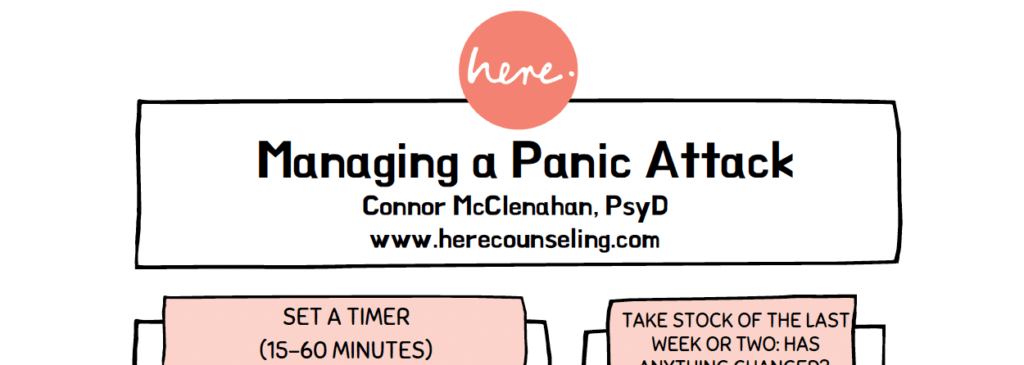Panic Attacks: Manage anxiety and return to calm
Panic attacks can be frightening and overwhelming. Many people worry about what’s happening to them, and they don’t know what to do to make it stop. We’re going to take you step by step through everything you need to know about anxiety, panic attacks, and some simple steps you can take (even today) to start resolving a panic attack.
What is a panic attack?
A panic attack is a sudden, painful collection of anxiety symptoms. Panic attacks often involve extreme tightness in your chest, a fast heartbeat, rapid breathing, and intense fear. Many people mistake panic attacks for heart attacks. Most panic attacks last for 15-60 minutes. After the intense period of anxiety, the pain decreases, and people usually feel exhausted from the heightened state of arousal.
Panic attacks can be debilitating. Many people who experience panic attacks often worry about going out with friends, to work, social situations, or the grocery store. They worry they’ll have a panic attack in public and won’t be able to control their anxiety.
What Do Panic Attacks Feel Like?
Panic attacks come on quite quickly and can be extremely overwhelming. Here’s how people often describe their panic attacks:
- I’m afraid. During a panic attack, you will likely experience debilitating fear or sheer terror.
- I feel physically shaken. Panic attacks cause a variety of physical symptoms, including chest pain or discomfort, lightheadedness, or nausea.
- I feel like I’m dying. Many people who have panic attacks describe feeling as though they are dying.
- I can’t think straight. In the grip of a panic attack, you might have trouble making decisions or remembering simple things.
- I’m afraid I’m going to have a panic attack in public. Many people who experience panic attacks often will avoid public spaces for fear that they’ll have an attack in public.
How Anxiety works in your body
Before we can understand panic attacks, we need to understand how your body is built to handle anxiety. Anxiety is not a bad or destructive feeling. In fact, anxiety is the body’s natural and helpful response to a threat in the environment. Anxiety is like a fire alarm that signals your body is feeling unsafe. The anxiety response follows a normal rising and falling path, like a river. Let’s take a look at what happens in your body when you feel anxiety, and how your body calms itself and returns to normal.
- When your body senses a threat in the environment, your amygdala —the fear center of your brain—sends a signal down your spinal cord to your heart to increase its speed and tension. Your body then prepares to fight or run away, as if your life depended on it.
- Your mind scans your body and notices there’s tension in your heart and muscles. It recognizes your tension as a response to something scary, and —if it’s not a life-threatening threat—begins to soothe itself.
- Like a river, your mind flows down a familiar track for how to soothe anxiety. Depending on how you deal with anxiety, you might take a deep breath, remind yourself of your value, cry, tell yourself that it’s going to be okay, or ask for help. These skills are acquired by having care-givers who consistently respond with empathy and soothing to our anxiety. Essentially, those experiences created the river, the way we know how to sooth ourselves when we’re anxious.
- While you soothe yourself, your vagus nerve stimulates your heart, slowing it down, releasing tension, and helping you feel open and collected again.
- Part of the soothing process is that you’re able to recognize why you were anxious. Because you feel calm, you’re able sense of your life and learn about what you’re needing.
How Panic Attacks Work in your Body
With a panic attack, the above anxiety “river” gets short-circuited. Let’s take a look at what happens during a panic attack.
- Similar to the anxiety response, the first signal of a panic attack is from your amygdala. Your body senses a threatin the environment and sends a signal down your spinal cord to increase your heart rate and prepare to fight or run away.
- Your body then senses your tension in your heart. In a panic attack, you don’t recognize this tension as normal or helpful. Instead of soothing anxiety, the signal is ignored. The fire alarm is dismissed, not paid attention to. We often ignore the signal by working harder, by scrolling social media, by busying ourselves.
- Because the anxiety isn’t soothed, it continues to build inside until a breaking moment: the threat overwhelms the coping strategies. If our normal anxiety response is a river, then a panic attack is like a dam that, after holding back too much water, breaks.
- It’s hard for the body to remain in a panic state for long. After the period of intense breathing, heart racing, and fear, the body will naturally calm itself down usually after 15-30 minutes, though occasionally it can take an hour or more.
- Often the original cause of anxiety is forgotten, due to the overwhelming experience of panic.
Where Do Panic Attacks Come From?
We’ve explored how panic attacks happen in the body, and it can also be helpful to know why you experience them. First of all, I recognize the limitations of a blog article to tell you – a specific and unique person – why you experience panic attacks. However, after treating many people in Downtown Los Angeles with panic attacks, here are some common themes I see in my practice. Panic attacks are often the result of:
- Ignoring stress. This is a common theme for people who suffer from recurring panic attacks. When they experience anxiety, they don’t pay attention to the feeling. Instead, they feel they’re being “weak” or “complaining”, or they feel guilty for needing to slow down at work. Instead of soothing their stress, they ignore it. They’re afraid to slow down or to take time for themselves to listen to the anxious feeling. Often when a person experiences a full panic attack, it’s after days, if not weeks, of suppressing (pushing down or avoiding) clear signs of being overwhelmed. While this strategy can work short term, your body needs a way to actually calm down and soothe itself.
- Not getting help. Self-care is sometimes a dirty word. We can feel selfish or guilty: “Other people don’t need to slow down! Other people don’t take a day off when they’re overwhelmed! I don’t think I deserve to have a day off or to have time to myself.” It can be hard – especially in a culture that expects a lot of us. It’s sometimes difficult to see how well your body and mind can function when you have permission and space to take a breath in, to soothe yourself.
How To Conquer Panic Attacks
The first step in conquering panic attacks: you can’t stop the panic attack. Now I know that doesn’t sound great. However, there’s a different and better way to help. Returning to that “river” versus “dam” analogy, when the dam breaks, all we can do is allow the feelings to be there. Here’s what you can do, step-by-step:
Set a timer
Most panic attacks last 15-60 minutes. While this experience is painful and sometimes scary, it can help to know that there is an end to the pain. Your body takes a while to calm back down from this experience.
Accept the experience and allow it to pass naturally
Take a deep breath in through your nose, and out through your mouth, slowly. Allow your belly to fill with air when you breath in. Picture a place you feel safe. Allow the bodily feelings to pass naturally, knowing it’ll be over soon.
Once the panic attack is done, relax
You’ll feel exhausted after the panic attack. Don’t feel any pressure to get up and go. Let your body recover – act as if you’ve just completed a marathon. Drink some tea, put on white noise, eat something healthy.
Take stock of the last week or two
Ask your self what was different this past week. What things in your life have added to your level of stress or responsibility? What other, smaller signals was your body giving you about your level of stress before the panic attack?
Learn to soothe anxiety
Conquering panic means learning to listen to the smaller anxiety signals your body gives you early on. It means practicing soothing, finding that easy flowing river that helps you move through anxiety, rather than dam it up. That’s what we do. We help anxious professionals in Downtown Los Angeles overcome anxiety and live their best lives.

Managing a Panic Attack Worksheet
Want these questions in an easy to use free downloadable worksheet? This worksheet will help you take steps forward in dealing with anxiety. You’ll also get access to all our worksheets in Here Counseling’s Resource Library!




